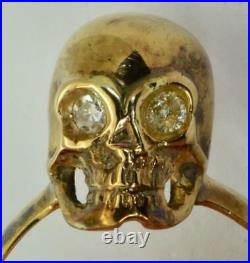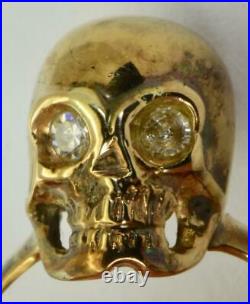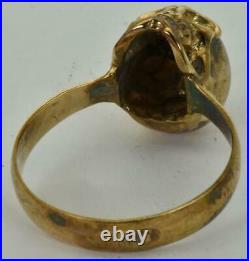RARE WWI Imperial Russian White Army Ace's 14k gold(56)&Diamonds Skull ring









RARE WWI Imperial Russian White Army Ace's 14k gold(56)&Diamonds Skull ring. The skull was an emblem of the " Death or Glory" - the 19th Detachment of the Imperial Russian Air Service.
The ring is signed with 56 Imperial Russian gold kokoshnik hallmark. In the First World War, men painted symbols on their aircraft as a talisman, or as a warning to the enemy, and what better icon to use threatening death and destruction than a skull and crossbones.
It was employed by almost every warring nations pilots: Germanys Lt. Pratt of 46 Squadron, Italys Capt.Fulco Ruffo di Calabria, Austrias Deputy Officer Julius Arigi, and by the men of Russias 19. Fighter Detachment, (usually written as XIX Detachment). While many pilots used the macabre design individually, it was the Russian Death or Glory 19. Corp Air Squadron that utilized it for the entire unit, proudly painting it on the rudder or tail surfaces of their aircraft.
Death or Glory was not an empty phrase to them. The unit included a number of Russias highest scoring aces. When the war started in August 1914, the 19.
Detachment was based at Warsaw as part of the Second Aviation Company. Starting on October 1, 1915, command of the Detachment was given to the man who would become the Imperial Russian Air Services most successful pilot, Cavalry Staff Captain Alexander A.
Kozakov (sometimes spelled as Kazakov). His squadron was initially equipped with outmoded and unarmed Morane Gs, Morane-Saulnier Ls, and Farman and Voisin pushers. But by the end of the month Kozakov had managed to procure a Nieuport 10 single seater with which to face the enemy on more even terms. The method of arming it with a machine gun proved difficult as, at the time, Russia did not have an effective interrupter gear.So the Nieuport had the weapon angled up at 24 degrees to fire over the propeller and with this arrangement, starting in February 1916, Kozakov sought out combat. It finally proved itself in Kozakov's hands that summer and more of the Nieuports were equipped in the same manner. The unit was withdrawn from the front in August 1916 to restructure it with larger air units and the 19. 2s, and supplemented with Russian-made Nieuports from the DUX works. Looking to establish a reputation within the First Air Combat Group, the 19.
Began painting white skull and crossbones on their black-colored rudders. So that the units pilots could identify his machines in the air, Kozakov reversed the scheme on his rudder, painting a black skull and bones on a white rudder. Auctiva offers Free Image Hosting and Editing. The item "RARE WWI Imperial Russian White Army Ace's 14k gold(56)&Diamonds Skull ring" is in sale since Saturday, April 17, 2021.
This item is in the category "Jewelry & Watches\Vintage & Antique Jewelry\Fine\Victorian, Edwardian 1837-1910\Rings". The seller is "riaerica2000" and is located in Sofia. This item can be shipped worldwide.